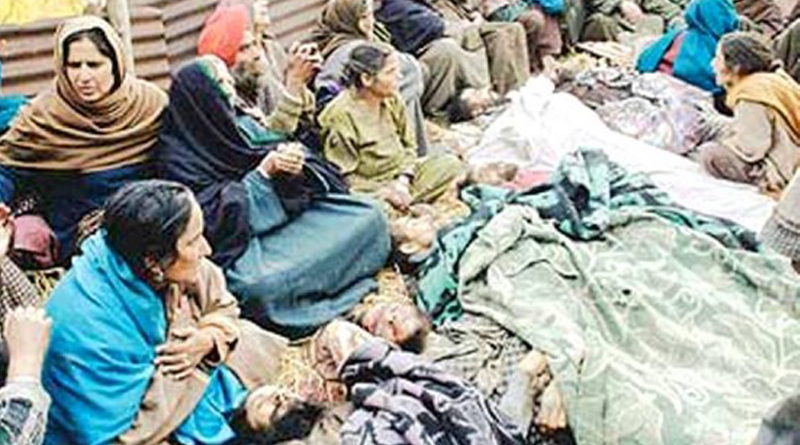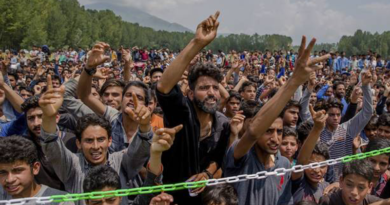Motives behind Sikh killings
The ghastly murder of 35 Sikhs in Kashmir some days back has shocked the freedom-loving people in and outside Kashmir. Since the killings took place on the eve of President Clinton’s visit to India, it made far more impact than otherwise it would have. The other reason for the big-bang effect was the fact that Sikhs had become the target for the first time during the ongoing movement in Kashmir. The unfortunate event has been widely commented upon during the past 3-4 days. Most of the commentaries have, however, chosen to focus on ‘who did this?’, and that is quite natural, because in such an unusual case this is where the human mind points first. Majority seems to agree on India being the real culprit in this blood bath. This is by the application of common-sense criterion ‘who stands to gain from such an action?’, and everybody, Indian analysts included, agrees that India and not the movement in Kashmir stands to gain from it. It is India’s propaganda line that gets reinforced by such an action. To my mind, more than who did this, what is important to ask is ‘why it was done?’. Future-oriented minds always rush to that side of the story. I am sure no body doubts that the plan was well thought through, there were definite, very serious and even long term (as opposed to ad hoc) motivations behind it. It seems to me that extremely criminal and sinister designs have motivated this action of Sikh-murder. I am, to my best ability, trying to understand what these designs could be, but so far not much is there for me to say with certainty, except of course a few observations that I can make now. But before doing that let me emphasise the point that digging into these designs is absolutely essential, if we want to safeguard the ongoing move for the liberation of Kashmir from India. We must know at every point what India is up to. Indian state is planning our destruction, that is our unshakable faith, but we must be always alert to see which new schemes are being contrived.
The planners of the Sikh tragedy aimed at achieving two objectives: First, create a proper context in which the movement in Kashmir, Pakistan and Islam and Muslims in general could be demonised and maligned; and second, drive a wedge between the Muslim and Sikh communities. Both these points have been discussed by people on the net and in print media as well. But let me dwell on them further in order to bring out their true meaning. The primary purpose of Sikh killings, as most of people have noted, was to malign the movement in Kashmir by portraying it as what India calls ‘ethnic cleansing’, as opposed to a genuine freedom movement. However a distinction needs to be made between maligning in real terms and creating an atmosphere that legitimises maligning. President Clinton, or for that matter any responsible person not to talk of a head of state, forms a definite opinion about various events and realities on the basis of authentic research-based reports.
What is Kashmir struggle, Bill Clinton and his administration, know it reasonably well. They have so many avenues of information (at times looking mind-boggling), well-funded institutions for its processing and analysis leading to formation of definite opinions and formulation of policy lines. A single event as that of the murder of 35 Sikhs cannot bring about a real change in Clinton’s perception of the movement in Kashmir: hitherto he thought it is a freedom movement, now he believes it is for ethnic cleansing. If all of us, and even the so-called man on the street, can quickly smell a mischief in such an action as the killing of Sikhs, why can’t Clinton, who being a president knows full well what the states do in pursuance of their political objectives. How dirty and criminal acts are ordered by the state. So the present event did not really change Clinton’s opinion, but it did something equally sinister: it provided the necessary context in which Clinton could say what he did, and also Vajpayee. So far Clinton endorsed India’s condemnation of terrorism, but this had remained confined to generalities; after the Sikh massacre it came down to specific, namely, to cross-border terrorism. This is what India wanted. Furthermore, Clinton said that violence must end (referring to the massacre) before India’s dialogue with Pakistan can start. Now, one can reasonably presume that this is what Clinton had planned to say in the first place, but he could have not without some spectacular event taking place highlighting the reality of ‘violence and cross-border terrorism’. Once the event took place, it, in a way, legitimised what Clinton said. Similarly, Vajpayee talked about the menace of terrorism, and in front of President Clinton at Hyderabad House, pledged to root out this menace saying that India had, both, resources and the will to do so.
These statements were not mere utterances of words, they were a deliberate expression of future intentions. For example, Clinton taking up the issue of Pak support to Kashmir movement with the leaders in Pakistan. Whether they will budge or not, will be clear, not so much by their verbal response to it, but by the ground situation in Kashmir as it develops in the next six months or so.
Likewise, when Vajpayee pledged to ‘root out the menace’ he was articulating his plans to come down on the movement with a further heavier hand, something that will match Vladimir Putin’s barbaric campaign in Chechnya. This campaign, one must note, created a dangerous precedence: movements for independence, howsoever genuine they are (the Chechen struggle for example which has 400-year history) can be crushed by a full-scale war using tanks, air power and everything else that is used in an inter-state war. The world at large allowed Putin to carry on by silently watchingthe genocide, and India openly supported its (Russia’s) ‘fight against terrorism’. It should be recalled that the present bloody campaign in Chechnya was initiated after a series of bomb blasts in Moscow, in which scores of Russian civilians were killed. Russia squarely blamed Chechen fighters for these killings, and Chechens in turn denied any involvement in these acts of terror. However these bombings could successfully create anti-Chechen feelings in Moscow, and could provide the context for an extremely bloody campaign that Russia was to launch later. Vajpayee might have same ambitions in his mind when he talked of ‘will and means’ to eliminate terrorism. By expressing these ambitions at an important function and before the head of the ‘only superpower’, Vajpayee was seeking endorsement of his destructive plans. All this could happen because the atmosphere was highly charged and conducive to every kind of tough talk. The dog had received the bad name and now the question before Vajpayee and his guest was how to hit it. This is essentially what the massacre of 35 Sikhs did.
Another no less important purpose was to sow discord between Sikh and Muslim communities. In order to understand its real import, one has to go beyond Kashmir. Sikhs are a well-knit community, anything that happens in Kashmir will have repercussions outside Kashmir and outside India as well. For the Brahmin state of India the factor of Sikh-Muslim relations is extremely important both internally as well as externally.
Historically, Sikhs were made into the muscle of the Brahmin to deal with the ‘outsider’ Muslim. This Brahmin-devised arrangement worked well, and Brahmins got rich dividends from it in 1947. With the emergence of the popular independence movement of Sikhs in the ’80s, and its brutal repression by the Brahmin state, things started changing. Sikhs identified Muslims as their fellow oppressed, and the Indian state as the common oppressor. Sikh-Muslim amity logically translated into Sikh-Pakistan amity.
Things went that far, that last year during Kargil fighting when a wider Indo-Pak conflict became imminent, patriotic Sikh leaders started articulating a radical position, namely, the soil of Punjab will not be allowed to be used for war with Pakistan anymore. This created serious doubts in the minds of India’s ruling elites regarding the political loyalties of Sikhs: at a critical time as that of war, Sikh loyalty cannot be taken for granted. The recent massacre has started influencing these changing equations.
Only the other day, there was a joint procession by Hindus and Sikhs in Delhi calling each other brothers and Muslims as the enemy. The Brahmin state of India stands to gain a lot from Sikh-Muslim discord. The BJP government in Delhi has already been trying with some success to engineer anti-Sikh changes in the Akali politics, SGPC (the highly resourceful organisation responsible for the management of Sikh gurdwaras) and Akal Takht (the highest Sikh religious seat).
The recent Kashmir episode will help further accelerate this process, that will have a negative effect on the growing movement of Sikh self-assertion. Sikhs already missed the bus in 1947: at the demise of British empire they could not provide their hard-working and brave nation the protective umbrella of an independent state; they could have as did the Muslims. Now they have woken up, made lots of sacrifices, but the danger is that Brahmin machinations may once again mislead them by a death embrace. Kashmir massacre has this potential.We have to stop this from being realised. Sikhs world-wide and all freedom and justice-loving people, Muslims on top of them, have to work towards this goal.
***
Dr. Syed M Inayatullah Andrabi is a well-known figure in the circles of political Islam. Born in Srinagar, the capital city of Indian Held Kashmir, Dr Andrabi has been intimately involved at the intellectual level with the global politics and political issues since his student days in 1980 at Pune (India), where he completed his Ph.D. in Linguistics in 1983 at the Centre of Advanced Study in Linguistics, Deccan College, University of Pune, Pune, India. Upon completing his doctorate he returned home to join the University of Kashmir, first on a post-doctoral fellowship and later as faculty, but could not continue because of the deteriorating security situation in Kashmir, and had to move to United Kingdom in 1994 where he continues to live since along with his wife and five children.




